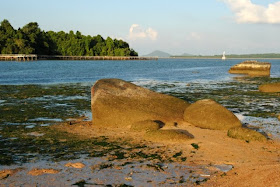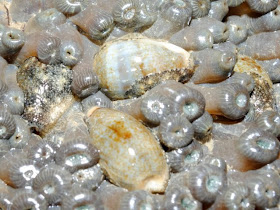Yesterday was the first time I visited Pulau Sekudu during an evening low tide! Just like BB, visiting Sekudu is an annual event which I would always look forward to.
Though this northern island just off Pulau Ubin is very small, Sekudu has many fascinating rock formations surrounded by a small stretch of sand bar and a large expanse of intertidal shore.
From far, we could see many shore birds feeding during low tide. There is even a small mangrove among the rocks on the high shore!
Pulau Sekudu is found just in front of Chek Jawa Wetlands (the boardwalk and beacon can be seen in this photo) and therefore requires special permission from NParks to land on this island. We were visiting with NParks permission to do a survey of the shore and to check for any abandoned drift nets or fish traps.
Pulau Sekudu is also known as the Frog Island and coincidentally, there is a rock formation that really looks like a frog! Somebody even drew an eye on it.
With no jetty, we landed with a long staircase from the boat. As usual, this is the best opportunity to take paparazzi photos. You can see in this photo that Rene is snapping shots of us climbing down the staircase.
Talking about Rene, she immediately found this Denison's nudibranch (Dendrodoris denisoni) as soon as we started looking at the shore. I saw three of them througout the trip!
Little did we realize that there were many more slug finds awaiting for us to discover.
James found this long orange slug that is probably Gymnodoris inornata.
I later came across another one which seems to be doing some stunts balancing itself on the seaweed. Haha!
If one were to look closely among the seaweed and seagrasses, it is not difficult to discover many of these Bushy slugs (Polybranchia orientalis).
There were many first slug sightings for me during this trip! The first would be this super tiny slug that looks like a purple sponge. Chay Hoon suggests that this is likely to be a Jorunna sp. Given its small size, it was rather back breaking to take a proper photo.
Mei Lin later found this bizarre looking slug with lots of zebra-looking patterns. This is probably a Philinopsis lineolata.
This slug is probably the juvenile version of the Rose nudibranch (Dendrodoris fumata). It is my first time encountering it in black/purple coloration. All my previous sightings were the orange versions.
More tiny slugs! We came across two Cerberilla sp. slugs. This is the first one!
And this is another one. Can you see the eye spots in both photos?
Apart from the usual Ornate leaf slugs (Elysia ornata) that are common on the shore, we also came across several of another species of the leaf slugs (Elysia sp.) which is slightly more wolly.
Though many slugs were sighted, I only saw one type of flatworm and this is the large Brown striped flatworm (Pseudobiceros gratus) which I have not seen for more than a year!
As usual, there were many sea stars found at Sekudu ranging from Crown sea star (Asterina coronata), Spiny sea star (Gymnanthenea laevis), Biscuit sea star (Gonodiscaster scaber), Cake sea star (Anthenea aspera), Scaly sea star (Nepanthia belcheri), Plain sand stars (Astropecten indicus) and the Painted sand stars (Astropecten sp.).
This is a pair of Cake sea stars (Anthenea aspera) that were beside one another when I found them.
And nearby, another pair of organisms- carpet anemones!
All over the shore, there were many Swimming anemones (Boloceroides mcmurrichi) of all sizes! This is a super small one found by Mei Lin.
What intrigues us would be this anemone that looks like a swimming anemone. It also behaves like one and is not attached to the substrate. We wonder what the identity is!
Whenever we squat or kneel down to look at stuffs, our eyes were greeted with another spectrum of living organisms. For example, many tiny anemones of all sorts of patterns and lifeforms seemingly popped out in front of our eyes. Many of which we are not confident of their identity.
One of the many unidentified sea anemones would be this Transparent spoke anemone with many interesting structures besides the tiny mouth. It really looks like a flower.
These white fan worms also do look like flowers in the garden of seaweed and seagrasses.
Found on a boulder will be this small mat of zoathids with lots of cowries found embedded among the branches. How many do you think you can spot in this photo?
There must be more than five because within this small portion, there are already four found close to each other! I wonder if the cowrie benefits from living among the zoanthids.
The number of Cerianthids (Order Ceriantharia) at Sekudu seem to have dropped! I'm not sure if anything is affecting their growth here. Nevertheless, I managed to still find a few of them and this particular one with white and purple-tipped tentacles is especially pretty.
Among the many sea cucumbers, this is one of the unidentified ones that we have been seeing on our northern shores.
Last but not least, I'll end off the post with my find of this handsome Estuarine seahorse (Hippocampus kuda). :-)
The tide during the trip was not low enough for us to explore the reefy portions of Sekudu. Well, that will be for next year's super low spring tide in the morning. Hope that this special shore will continue to thrive.





























No comments:
Post a Comment